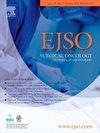Impact of minimal invasive surgery techniques on long-term health-related quality of life in rectal cancer: a Dutch cohort study
IF 3.5
2区 医学
Q2 ONCOLOGY
引用次数: 0
Abstract
Objective
Limited data exists on health-related quality of life (HRQoL) after robot-assisted surgery (RAL) for rectal cancer beyond one-year post-surgery. This study compares long-term HRQoL following RAL total mesorectal excision (TME) to conventional laparoscopic (CL) TME.
Methods
All rectal carcinoma patients from the 63-center Prospective National CRC cohort (PLCRC) who completed pre- and post-operative HRQoL questionnaires (EQ-5D, QLQ-C30, and QLQ-CR29) were retrospectively included. Delta scores per parameter were calculated by subtracting pre-operative scores from scores at one year. Sensitivity analysis included all patients with beyond one-year post-operative questionnaires, regardless of a pre-operative questionnaire. Data were analyzed using multivariate linear regression.
Results
Patients undergoing RAL TME more often had low rectal tumors, more post-operative complications and more stomas. In patients with both pre- and post-operative questionnaires, no significant differences were found in the EQ-5D delta score (n = 591). The QLQ-C30 (n = 709) showed statistically significant and clinical relevant difference in fatigue favored CL TME (4.4 ± 1.9, p = 0.021). The QLQ-CR29 (n = 696) showed small, statistically significant differences favoring RAL in body image and stoma-related issues, but no clinical relevance. Sensitivity analysis EQ-5D (n = 1250), QLQ-C30 (n = 1423) or QLQ-CR29 (n = 1453) showed no clinically relevant differences.
Conclusion
This is the first study comparing long-term HRQoL between CL and RAL surgery for rectal cancer. Although several statistically significant differences were found, no clinically relevant differences were observed except for a small difference in the subdomain fatigue of the EORTC QLQ-C30 favoring CL surgery. Furthermore, the current study underlines the relevance of a pre-operative HRQoL assessment.
微创手术技术对直肠癌患者长期健康相关生活质量的影响:荷兰队列研究
目的直肠癌机器人辅助手术(RAL)术后1年以上健康相关生活质量(HRQoL)数据有限。本研究比较了RAL全肠系膜切除术(TME)和常规腹腔镜(CL) TME后的长期HRQoL。方法回顾性分析63个中心前瞻性全国结直肠癌队列(PLCRC)中所有完成术前和术后HRQoL问卷(EQ-5D、QLQ-C30和QLQ-CR29)的直肠癌患者。每个参数的Delta评分由术前评分减去1年的评分计算。敏感性分析包括所有术后问卷超过一年的患者,无论术前问卷如何。数据采用多元线性回归分析。结果经尿道直肠切除术患者直肠低位肿瘤发生率高,术后并发症多,造口多。在接受术前和术后问卷调查的患者中,EQ-5D delta评分无显著差异(n = 591)。QLQ-C30评分(n = 709)在疲劳倾向CL - TME评分上差异有统计学意义(4.4±1.9,p = 0.021)。QLQ-CR29 (n = 696)在身体形象和造口相关问题上表现出有利于RAL的小而有统计学意义的差异,但没有临床相关性。敏感度分析EQ-5D (n = 1250)、QLQ-C30 (n = 1423)、QLQ-CR29 (n = 1453)无临床相关差异。结论本研究首次比较直肠癌CL和RAL手术的长期HRQoL。虽然发现了一些具有统计学意义的差异,但除了EORTC QLQ-C30倾向于CL手术的亚域疲劳有微小差异外,没有观察到临床相关的差异。此外,目前的研究强调了术前HRQoL评估的相关性。
本文章由计算机程序翻译,如有差异,请以英文原文为准。
求助全文
约1分钟内获得全文
求助全文
来源期刊

Ejso
医学-外科
CiteScore
6.40
自引率
2.60%
发文量
1148
审稿时长
41 days
期刊介绍:
JSO - European Journal of Surgical Oncology ("the Journal of Cancer Surgery") is the Official Journal of the European Society of Surgical Oncology and BASO ~ the Association for Cancer Surgery.
The EJSO aims to advance surgical oncology research and practice through the publication of original research articles, review articles, editorials, debates and correspondence.
 求助内容:
求助内容: 应助结果提醒方式:
应助结果提醒方式:


